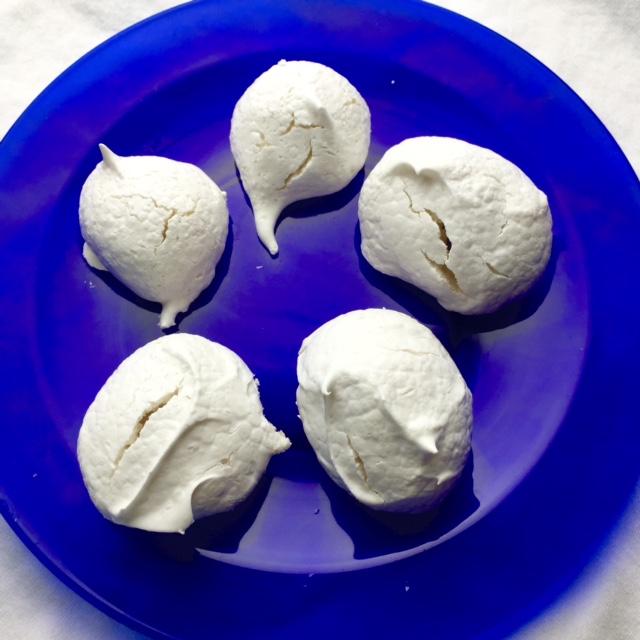Vegan Meringue Cookies

Hold on to your spatulas, you'll love this one!
One of my favorite memories growing up is when my mom made meringue cookies. She learned early on to not have me around when she was making the batter because I would relentlessly sneak the light and fluffy sugary nectar. The wait was torturous as the little dollops of puff would slowly turn into airy crisp sweetness that literally melted in your mouth. Since 2008 meringue has been off the menu as eggs are no longer a part of my diet, however, the chickpea has now brought meringue back!
A funny new word, Aquafaba is simply the juice that is in the can of beans (Aqua is latin for "water" and faba is latin for "bean"). Using this aquafaba, sugar and a little cream of tartar, you'll be whipping up meringue in no time.
I was inspired by the Facebook page: Vegan Meringue - Hits and Misses. I encourage you to visit and explore, too.
Ingredients
Setup
juice from 14 oz can of cooked chickpeas (about one cup)
3/4 C granulated sugar
1 tsp cream of tartar
Directions
Drain the can of chickpeas into a bowl and let it sit for a few minutes to get as much juice as you can off the beans ***Do not rinse them***.
Preheat your oven to 225-degrees F.
With a hand blender on the highest speed, begin to whip the aquafaba until you begin to see peaks, this take me about 15 minutes, stay patient.
Slowly add in the sugar, about a teaspoon at a time making sure there is no grittiness in between each scoop. This takes an additional 10 minutes. By now, you should have very sturdy peaks, but you'll still want to add in a stabilizer. Add in 1 tsp of cram of tartar and and continue to blend another minute.
Line a cookie sheet with parchment paper and using a spoon, scoop 1-1 1/2 TBS of the fluffy mix on to the sheet and bake for 95 minutes. Turn off your oven and crack open the door to allow them to cool completely. Store in an airtight container.
NOTES:
The aquafaba in the chickpea can will vary. This recipe is for 1 cup of aquafaba. I have discovered that 3/4 C of sugar works nicely. However, if I only wound up with 3/4 C aquafaba, I would bring the sugar down to 1/2 C.
Ovens will vary. I have one gas and one electric, the gas oven did a lot better at setting the cookies up and keeping them crisp, though I did have the random chewy (but still delicious) little sucker. Because using aquafaba is so new in the culinary world, we are all still trying to figure it out. There are a lot of variables such as organic, not organic, salt, no salt added, juice from a box or a can, oven types, altitudes, etc.. However, you WILL nail it and once you do, you're set. Have fun!
_____________
Do you know about our STREAMING PLUS membership?
Our membership is built like a streaming service - you get a full library of plant-based cooking classes to watch whenever you want. PLUS, you gain access to upcoming interactive virtual cooking classes and a monthly accountability group call.
As a member you get:
- Complete library of all past virtual classes - stream them whenever you’d like!
- Free access to upcoming virtual classes
- Library of easy and quick recipes: 100 and growing
- Access to private Facebook group
- Monthly accountability check-in and support group Zoom call with Caryn
- Quarterly “Ask the Doc” call with Dr. Jim Loomis, our Medical Director
- A community of support
To learn more, please visit us here.
